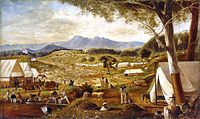
Photo from wikipedia
ABSTRACT This article uses census data for England and Wales covering the period 1851–1911 to provide new insights into patterns of migration to London. It examines several related themes including… Click to show full abstract
ABSTRACT This article uses census data for England and Wales covering the period 1851–1911 to provide new insights into patterns of migration to London. It examines several related themes including the role migration played in London’s growth during this period, age and gender differentials and distance travelled. Calculating net migration rates, the article demonstrates that after age 30, of those born outside of London, more left the Capital than came, yet over time an increasing proportion of the migrant population was retained. The proportion of family migrants fluctuated over the period, yet compared to others tended to travel shorter distances, a feature which increased over time with suburbanization. Turning to the geographical origins of migrants, London drew migrants from across the entirety of England and Wales. However, the data suggest that the migrant sex ratio became more homogeneous over time, with distinct pockets of male dominated migration that were visible in 1851 disappearing by 1911. Lastly, the article investigates migration from the perspective of place of departure rather than destination, as is traditionally the case. This reveals a distinct regional geography, suggesting that the present-day north–south divide was already evident in 1851, and became increasingly distinct over time.
Journal Title: Social History
Year Published: 2019
Link to full text (if available)
Share on Social Media: Sign Up to like & get
recommendations!